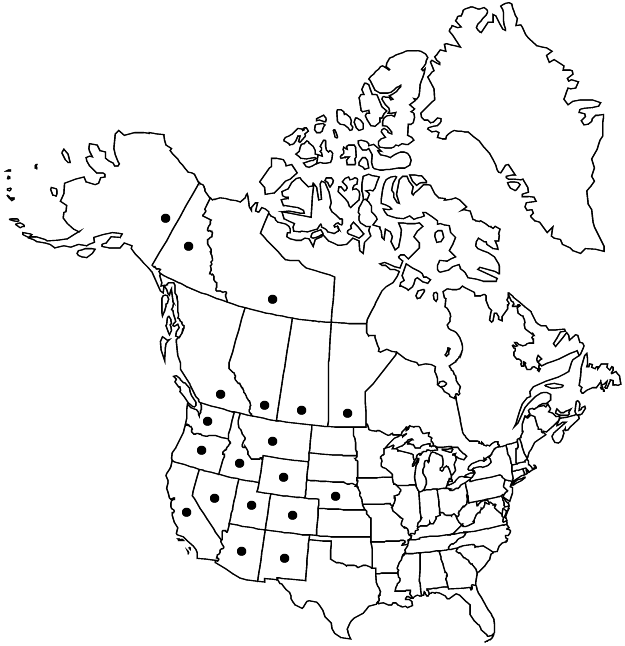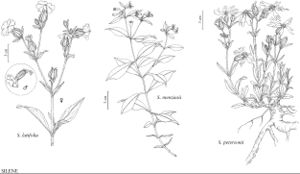Difference between revisions of "Silene menziesii"
Fl. Bor.-Amer. 1: 90, plate 30. 1830.
FNA>Volume Importer |
FNA>Volume Importer |
(No difference)
| |
Revision as of 20:08, 24 September 2019
Plants perennial, with several–many decumbent, sometimes cespitose or matted shoots; taproot slender. Stems decumbent to erect, simple or branched, leafy throughout, 5–30(–70) cm, usually glandular-puberulent distally, proximal pubescence varying from short and sparse to multicellular, crinkled and deflexed, glandular or not. Leaves 2 per node, sessile or short-petiolate; blade usually oblanceolate to elliptic-lanceolate, rarely obovate or elliptic, 2–6(–10) cm × 3–20(–35) mm, broadest at or above middle, narrowed to base, margins ciliate with short, somewhat scabrid hairs, apex acute to acuminate, puberulent to pubescent. Inflorescences cymose, or flowers axillary or solitary and terminal; cyme loose, compound, leafy. Pedicels slender, 0.5–3 cm, glandular-puberulent. Flowers functionally unisexual, usually bisexual; calyx obscurely 10-veined, campanulate, 5–8 mm, ca. 1/2 as wide, herbaceous, margins dentate, lobes lanceolate, 1.5–3 mm, apex recurved, subacute to acuminate, puberulent to pilose and glandular, veins without conspicuous, pale commissures; corolla white, clawed, 1–11/2 times calyx, claw shorter than calyx, limb oblong, 2-lobed, 1.5–3 mm, lobes oblong, apex obtuse, appendages 2, small, 0.1–0.4 mm; stamens in functionally staminate flowers equaling corolla, otherwise reduced and included in calyx; stigmas 3(–4), equaling corolla in functionally pistillate flowers, otherwise included in calyx, papillate along whole length. Capsules green, becoming black, ovoid-ellipsoid, slightly longer than calyx, opening by 3 erect teeth which often split into 6; carpophore ca. 1.5 mm. Seeds black, not winged, broadly reniform, 0.5–1 mm, glossy, obscurely reticulate. 2n = 24, 48.
Phenology: Flowering throughout summer.
Habitat: Common in open woodlands and forests, grasslands, gravelly places, river banks, mountains farther south
Elevation: 200-3000 m
Distribution

Alta., B.C., Man., N.W.T., Sask., Yukon, Alaska, Ariz., Calif., Colo., Idaho, Mont., Nebr., Nev., N.Mex., Oreg., Utah, Wash., Wyo.
Discussion
Silene menziesii is quite variable in the extent to which the inflorescence is developed and in its pubescence. This, coupled with the functionally dioecious nature of the species, has spawned a plethora of names, none of which appear to warrant recognition. The similar S. williamsii from Alaska and the Yukon Territory can be separated by its narrower lanceolate leaves that are broadest near the base and dull, usually brown, tuberculate seeds. Also, its stigmas are papillate only near the top. Silene seelyi is also very similar to S. menziesii but has dark red flowers and leaves that are smaller (to 2 cm in length) and broadest below the middle.
Selected References
None.
